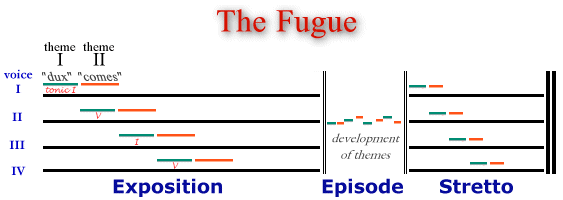|
Composers

Beethoven

Bach

Brahms

Hindemith
|
 Fugue
A musical work built on the principle
of polyphonic imitation, that is independent voices imitating each other
and merging into one musical compound Fugue
A musical work built on the principle
of polyphonic imitation, that is independent voices imitating each other
and merging into one musical compound .
Like the canon .
Like the canon ,
a fugue single voice ("comes")
pursues its prior ("Dux"),
and there is an imitation of the subject from one voice to another. Yet
when a canon is based on a perfect imitation (one melody repeating in all
voices), the fugue is based on subjects shifting from voice to voice, and
at the same time we hear counter subjects and different modifications on
these subjects (retrograde, inversion, diminution, augmentation etc.).
The fugue blossomed mainly during
the Baroque ,
a fugue single voice ("comes")
pursues its prior ("Dux"),
and there is an imitation of the subject from one voice to another. Yet
when a canon is based on a perfect imitation (one melody repeating in all
voices), the fugue is based on subjects shifting from voice to voice, and
at the same time we hear counter subjects and different modifications on
these subjects (retrograde, inversion, diminution, augmentation etc.).
The fugue blossomed mainly during
the Baroque ,
and as in all other baroque forms (except opera), German ,
and as in all other baroque forms (except opera), German master of fugue Johann
Sebastian Bach
master of fugue Johann
Sebastian Bach excelled
excelled  ,
as in Goldberg Variations ,
as in Goldberg Variations ,
the "Well-Tempered Clavier"
and especially at the height of his work "Art
of the Fugue", in which he demonstrated
every technique of the polyphonic ,
the "Well-Tempered Clavier"
and especially at the height of his work "Art
of the Fugue", in which he demonstrated
every technique of the polyphonic treatment of themes. After Bach, the fugue
was exhausted as a musical form, and except for Beethoven
treatment of themes. After Bach, the fugue
was exhausted as a musical form, and except for Beethoven and few romantic composers who tried to revive
the baroque forms (the neo-classicists like Brahms
and few romantic composers who tried to revive
the baroque forms (the neo-classicists like Brahms ),
it was not a common form of composition. In the 20th century only a few
composers like Hindemith ),
it was not a common form of composition. In the 20th century only a few
composers like Hindemith ("Ludus Tonalis")
wrote in this form.
("Ludus Tonalis")
wrote in this form.


Examples Fugues
 Little Fugue in Gm, BWV.578
by J.S. Bach
Little Fugue in Gm, BWV.578
by J.S. Bach
|
 Fugue on piano
by J.S. Bach
Fugue on piano
by J.S. Bach
|
|
Xtend
 Listen
Listen
 Period
Period
 Scheme
Scheme
 Notes
Notes
 Dictionary
Dictionary
 Internet
Internet
 Projects
Projects
 Finders
Finders
|